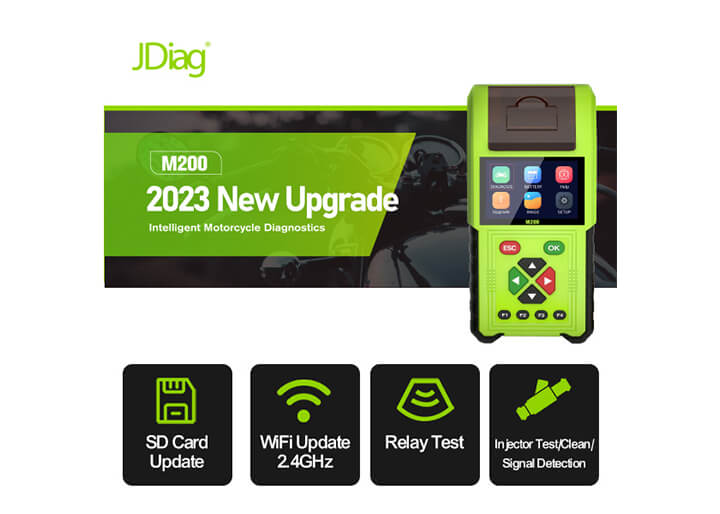In today's fast expanding motorcycle environment, accurately diagnosing any technical difficulties is critical for both riders and mechanics. JDiag, a well-known name in automotive diagnostics, has released its ground-breaking product, the JDiag M200 Motorcycle Diagnostics. This powerful diagnostic tool not only matches the demands of modern motorcycles, but it also offers a number of selling characteristics that set it apart from its competitors.
Comprehensive Compatibility:
With support for multiple motorcycle brands and models, including popular manufacturers such as OBD II, ADIVA, AEON, APRILIA, ARCTIC CAT, BAJAJ, BENELLI, BMW, BRIXTON, BOMBARDIER, CFMOTO, HARTFORD, HONDA, HYOSUNG, HERO, INDIAN, KAWASAKI, KTM, KYMCO, MODENAS, PGO, PIAGGIO, ENFIELD, SUZUKI, SYM, TVS, TRIUMPH, VESPA, YAMAHA, YIBEN. The M200 is an all-in-one solution to diagnose issues across various motorcycles.
The JDiag M200 best motorcycle obd 2 scanner equipped with dual system diagnostics, motorcycle system diagnostics and battery system diagnostics. From reading and clearing fault codes to retrieving real-time data streams and performing active tests, this diagnostic tool empowers users to diagnose and address problems efficiently. capabilities.
Offers an impressive range of diagnostic functionalities, users can identify and troubleshoot issues with precision.
How does a signal simulator help in repairing a motorcycle?
The signal simulator feature can be quite useful when servicing motorcycles! It helps simulate electrical signals within the bike's electrical system, the technicians can diagnose and troubleshoot problems more effectively.
By connecting to various sensors, switches, and components in the motorcycle, the signal simulator can mimic the signals generated under different conditions. The technicians to observe how the motorcycle's electrical system responds without the need for actual road testing or manipulation of real-world factors.
For example, if there is an issue with the ignition system, the signal simulator can generate the necessary signals to test the ignition coils, spark plugs, and other related components. By observing the response of these parts under simulated conditions, technicians can determine if there are any faults or malfunctions.
The injector test and cleaning feature is a valuable tool when repair motorcycles as it focuses on the fuel delivery system, specifically the injectors.
How do I know if my motorcycle injectors are bad?
Over time, fuel injectors will become clogged or damaged, leading to poor fuel spray patterns and inefficient combustion. Its result in issues like rough idling, reduced fuel efficiency, power loss, and even engine misfires.
Injector Testing: The technicians to evaluate the performance of each injector individually. By connecting the motorcycle's fuel system to the equipment, this way can activate and monitor the injectors to working correctly. This helps identify any faulty injectors that need to be replaced or serviced.
Injector Cleaning: The feature helps dissolve deposits, varnish, and other contaminants that may have built up within the injectors. By running the cleaning process, the injectors can be freed of blockages and restored to their optimal spraying performance.
The relay function is important in motorcycle repair, it helping control the flow of electrical power to various components and systems.. It acts as a switch that allows or interrupts the power supply based on specific conditions or signals.

What does a relay do on a motorcycle repair?
Electrical Component Control: Motorcycles have numerous electrical components such as the starter motor, headlights, turn signals, horn, and more. Relays help control the power supply to these components, for necessary electrical current to function properly.
Circuit Protection: Relays have built-in circuit protection features such as fuses or circuit breakers. These protective mechanisms safeguard the electrical system against power surges, short circuits, and overloading. If an issue arises in a particular circuit, the relay will automatically cut off the power supply to prevent further damage.
Control of High-Current Devices: Some electrical components, such as the starter motor or fuel pump, require a higher amount of current to operate. Relays are capable of handling high current loads and act as intermediaries between the control circuit (switch or computer) and the high-current device. This ensures that the control circuit is not overwhelmed by the heavy current draw.



